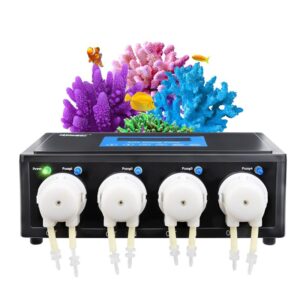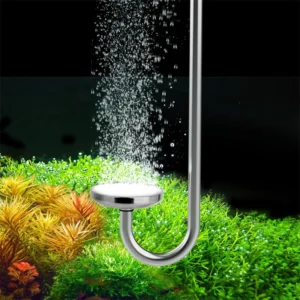Nowadays, more and more planted invert tanks are preferred by aquascapers and hobbyists of nano aquarium who seek lively self-sustained environment with low biological waste. These aquariums combine such freshwater plants and invertebrates like shrimp, snails and micro-crustaceans to create an awe-inspiring, self-contained aquatic world that resembles genuine freshwater environments.
Content Table
The interplay of aesthetics and biological intricacy makes a planted inverted tank, an in-depth understanding of its operation is advantageous tank. This guide is to describe what is planted in invert tanks, how they function as ecosystems, and the main practices for maintaining clean planted invert tanks.

what is a planted invert tank
What Is a Planted Invert Tank?
An aquarium for planted invert tanks accepts a wide range of aquatic inverts – the invert-tank species with the plants included – namely, dwarf shrimp species (for instance, Neocaridina and Caridina), snails (Nerite, Ramshorn, and Mystery) and even in some cases, small non-aggressive aquatic insects or amphipods, respectively. Plants provide biofilm, safe havens, and moisture control, but the first two are done by the invertebrates in charge of algae, decay, and scraps.
Key features and peculiarities of a planted inverted tank include:
- Low Bioload Compatibility
Other invertebrates such as shrimp, snails and dwarf crayfish produce far lesser volumes of ammonia and organic waste than fish. This takes a priority position in tanks where there is heavy plant growth because there are usually excess nutrients, leading to algae proliferation. The low discharge of waste inverts supports clearer water and the proper functioning of the tank’s filtration and plant system.
- Plant-Invert Symbiosis
Java moss, Anubias, and Subwassertang plants provide surfaces for biofilm development for maintaining microfauna, which are shrimp food. On the flip side, invert support by consuming algae, clearing detritus, and feeding on the leftovers, which promotes plant health while curbing the use of chemical algae treatments.
- Sensitivity to Water Parameters
Caridina shrimp, and other inverts are very sensitive to copper, ammonia, nitrite, as well as rapid changes of GH, KH, or TDS. A few medications and fertilizers containing copper can be fatal, even in small amounts. To reduce the risk of sudden die-offs, it is wise to test your water regularly, and ensure that all fertilizers used are copper free.
- Ideal for Nano Tanks
Inverted tanks, which are often planted, tend to naturally come in at 5 to 20 gallons, so they make for a great solution for an apartment dweller or someone who just does not have a lot of room available. Due to their small size, they are beautiful and attractive displays that easily fit in the desks, counters, or shelves.
How Does an Inverted Aquarium Work?
The term “inverted aquarium” has multiple interpretations, but for planted inverted tanks, it often refers to either:
- A tank with an inverted dome or tower filled with water above the surface line, creating an eye-catching visual where inverters or fish swim above the tank.
- A conceptual inversion where the focus is shifted from fish to plants and invertebrates, prioritizing ecosystem health over fish stocking.
If you opt for a gravity-based inverted structure:
- Physics of the Inversion: The dome filled with water remains above the surface line in the tank under the pressure of air. The inverted dome stays in position until fresh air supersedes it in the system.
- Visual Aesthetics: These domes present an odd view, particularly well known for shrimps, which sometimes move inwards when the dome is used against the tank surface.
- No Impact on Filtration:Although the dome is not affected by the chemistry of water and filtration, stagnant water in that dome may become an issue unless kept in motion.
For the second interpretation, the focus lies on:
- Biological Filtration: Good organisms in the tank break down waste into substances that are not harmful.
- Self-Sustaining Design: Once your planted tank has a healthy invert community, it can achieve a natural equilibrium with little maintenance.

planted invert tank
Planted Invert Tank Maintenance
Regular care and consequent plant and insect needs are crucial for achieving a healthy planted inverted tank. The important areas you should look after are these:
1. Water Parameters
- Ideal Temperature: 72°F to 78°F.
- pH: Between 6.5 and 7.5, depending on the species.
- GH/KH: Use remineralized RO water to maintain stable General and Carbonate Hardness (GH 4-6, KH 0-2 for Caridina; GH 6-8, KH 3-5 for Neocaridina).
- Ammonia/Nitrite: Always 0 ppm.
- Nitrate: Under 20 ppm.
- TDS (Total Dissolved Solids): 150-250 ppm for Neocaridina; 100-200 ppm for Caridina.
2. Filtration and Aeration
- Use sponge filters to avoid sucking up inverts and to provide gentle flow.
- Avoid strong currents; many invertebrates thrive in calm waters.
- Ensure there is surface agitation for oxygen exchange.
3. Substrate and Fertilization
- Choose nutrient-rich substrates like inert soil for root-feeding plants.
- Use invert-safe liquid fertilizers that are copper-free.
- Supplement root tabs near heavy feeders like Cryptocoryne and Amazon Swords.
4. Lighting
- Moderate intensity (PAR 20-40) for 6–8 hours daily.
- Use a full-spectrum LED fixturelike the hygger 058.
- Use a timer to prevent photoperiod fluctuation.
5. Feeding Practices
- Feed shrimp-specific pellets or blanched vegetables like zucchini, spinach, or cucumber.
- Feed sparingly—2-3 times a week. Overfeeding is a primary cause of algae and poor water quality.
- Ensure food is consumed within 2 hours to avoid decay.
6. Algae Management
- Introduce Nerite snails, Amano shrimp, or Ottocinclus (only if fish are desired).
- Manual removal with a soft algae brush or magnetic scraper.
- Maintain a balance between nutrients, CO2, and light to prevent outbreaks.
7. Plant Care
- Trim fast-growing plants like Hygrophila or Rotala weekly.
- Remove decaying leaves to prevent ammonia spikes.
- Propagate runners and cuttings to prevent overcrowding.
8. Most Critical Point: Stability Over Perfection
- Avoid sudden changes in temperature, TDS, or water chemistry.
- Always acclimate new inverts slowly using the drip method via a dosing pump.

planted invert tank maintenance
Maintenance Schedule of an Inverted Tank
A disciplined schedule ensures your tank remains stable and visually appealing. Here’s a refined maintenance schedule:
Daily
- Visual inspection of plants and insects.
- Top off evaporated water with RO water to maintain TDS.
- Ensure all equipment (filters, heaters, lights) is functioning.
Every 3 Days
- Feed inverts with supplemental food.
- Observe feeding behavior and remove uneaten food after 2 hours.
Weekly
- 10-15% water change using pre-conditioned or remineralized RO water.
- Test parameters: pH, GH, KH, nitrate, and TDS.
- Prune plants and remove algae manually.
- Clean the sponge filter with tank water.
- Vacuum detritus with a shrimp-safe siphon.
Biweekly
- Inspect the substrate and gently stir non-planted areas to release gas pockets.
- Replace or insert new root tabs for heavy-feeding plants.
- Check the CO2 diffuser (if used) and clean for optimal diffusion.
Monthly
- Deep clean decorations and rocks with a soft brush.
- Clean the light fixture to ensure maximum output.
- Reevaluate livestock numbers; consider culling or rehoming excessive shrimp.
- Review plant layout; thin out overgrown areas.
Quarterly
- Replace carbon or phosphate-removing media if used.
- Recalibrate digital testing equipment or pH probes.
- Backup or update logbook/journal entries with tank progress.
Pro Tips:
- Label water change containers to avoid contamination.
- Use a dedicated TDS meter to maintain consistent mineral levels.
- Consider keeping a tank log to track health and ecosystem.

Maintenance of an inverted tank
To Summarize
This type of tank effortlessly merges vivid aquatic plants and curious actions of the invertebrates in a closed, self-sufficient aquatic environment. Its life depends on frequent water conditions, appropriate lighting, and mild maintenance patterns.
The right selection of the substrate, appropriate methods of fertilization, and a schedule of proper care all contribute to fore the health of your plants and inverts together.
These tanks with low bioload and splendorous aesthetics are a great choice for aquarists looking to have an effortless but esthetically appealing setup. Concentration should be laid on keeping constant routines rather than chasing perfection, and your planted invert tank will thrive with extra vigor and balanced ecosystems.


Leave a comment